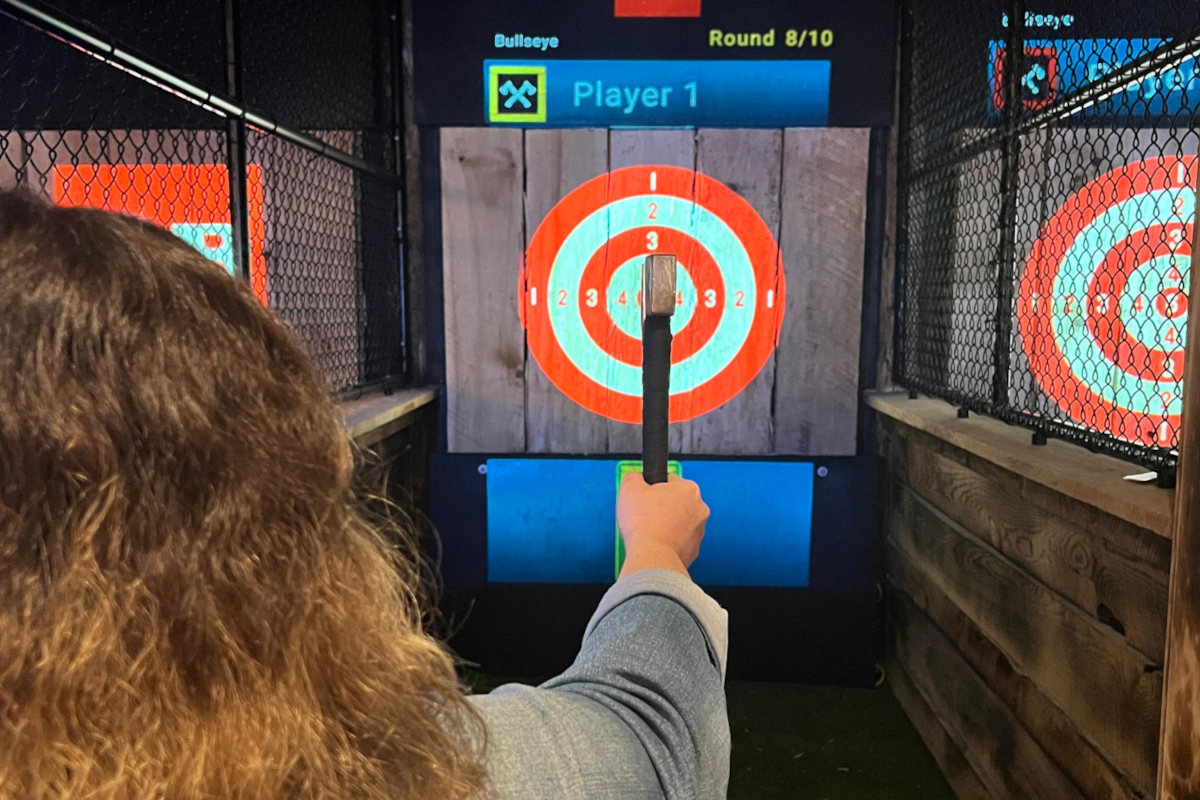Axe Throwing Denver: A Special Date Night Idea That Impresses
The Fun of Axe Throwing: Exactly How This Sport Incorporates Ability and Adrenaline for a Great Time
Axe throwing has become a captivating sporting activity that masterfully intertwines the requirement for accurate skill with the rush of adrenaline, offering individuals a distinct and interesting experience. The act of tossing an axe towards a target requires concentration and method, at the same time fostering an ambience of friendship and friendly competition. This appealing blend of psychological focus and physical exertion has made axe throwing a popular choice for those looking for both recreation and a sense of success. To absolutely appreciate the depth and charm of this activity, one need to consider its origins, the needed tools, and the foundational techniques that make sure both security and satisfaction.
The Beginnings of Axe Throwing
Axe tossing, an entertainment activity that has actually acquired significant popularity in recent years, traces its roots back to ancient times. The earliest documents of axe usage in affordable contexts are located among the Celts and Vikings, who threw axes for sport as well as in combat training.
Medieval European warriors, specifically throughout the Center Ages, exercised axe throwing as part of their martial training. The Francisca, a sort of throwing axe used by the Franks, came to be renowned for its fatal precision. This conventional tool was developed to be tossed at enemy guards and armor, showcasing its dual energy in both sporting activity and battle.
In even more recent history, axe tossing saw a resurgence in the logging camps of The United States and copyright in the 20th and 19th centuries. Lumberjacks would involve in pleasant competition, testing their accuracy and toughness by intending at wood targets. This development from a survival skill to a recreational activity has actually paved the means for its contemporary renewal, with specialized places and leagues now commemorating the sport globally.
Equipment You Need
Recognizing the rich history of axe throwing boosts the gratitude of the sporting activity's modern-day iteration. For leisure and competitive axe tossing, the most generally utilized type is the hatchet, commonly evaluating in between 1.25 to 2 extra pounds with a handle size of about 16 inches.
Similarly important is the target. Regulation targets are created from wood, with softwood varieties like yearn or cottonwood being liked for their ability to hold the axe and take in. The target is generally split right into 5 concentric circles, each with a details point value, to help with rating.
Safety and security equipment, though commonly ignored, is important. Protective gloves can improve grip and stop sores, while closed-toed footwear are a should to protect feet from dropped axes (axe throwing denver). A well-lit, spacious tossing location, complete with safety barriers, guarantees a controlled environment where individuals can concentrate on honing their abilities.
Basic Techniques Explained
Understanding the essential techniques of axe throwing is vital for both security and efficiency. The dominant hand needs to be positioned straight below the axe head, while the non-dominant hand sustains the end of the handle.
Next, concentrate on the position. Stand with your feet shoulder-width apart, guaranteeing your body is stabilized. Your leading foot must be a little forward, aligning with your target. This positioning aids in preserving security and guiding power precisely towards the target.

Safety And Security First
Making certain security in axe throwing is paramount to creating an injury-free and satisfying experience. A properly designed axe throwing facility attributes clear separations between tossing lanes, tough backgrounds to capture roaming axes, and non-slip floor covering to prevent accidents.
Advantages of Axe Throwing
Axe throwing deals a myriad of benefits that extend past straightforward entertainment. Physically, it supplies a full-body exercise, engaging muscular tissues in the arms, shoulders, back, and core. The recurring activity of throwing the axe additionally boosts hand-eye coordination and fine motor skills. For those looking to boost their general physical fitness, axe throwing can act as a vibrant and engaging form of workout.
Psychologically, axe tossing requires focus, approach, and accuracy, making it an excellent means to develop cognitive abilities. The focus required to hit the target can work as a type of mindfulness, permitting individuals to remove their minds and lower stress. This psychological engagement can be especially advantageous in assisting people create much better problem-solving skills and psychological durability.
Socially, axe throwing is commonly appreciated in team setups, cultivating team-building and friendship. Whether as component of a company occasion or an informal trip with pals, the sporting activity encourages interaction and partnership. Furthermore, the public experience of finding out and enhancing with each other can strengthen relationships and produce long lasting memories.
Conclusion

The earliest documents of axe usage in competitive contexts are found among the Celts and Vikings, that tossed axes for sporting activity as well as in fight training. Launch the axe when your hands are about at eye degree, allowing the axe's all-natural rotation to guide it in the direction of the target.
A well-designed axe tossing center functions clear demarcations in between tossing lanes, tough backdrops to catch stray axes, and non-slip floor covering to stop crashes. Participants must be advised on the right way to manage and toss the axe, stressing regulated, calculated motions over powerful tosses.
In summary, axe tossing stands out as a sport that masterfully integrates precision, adrenaline, and skill.